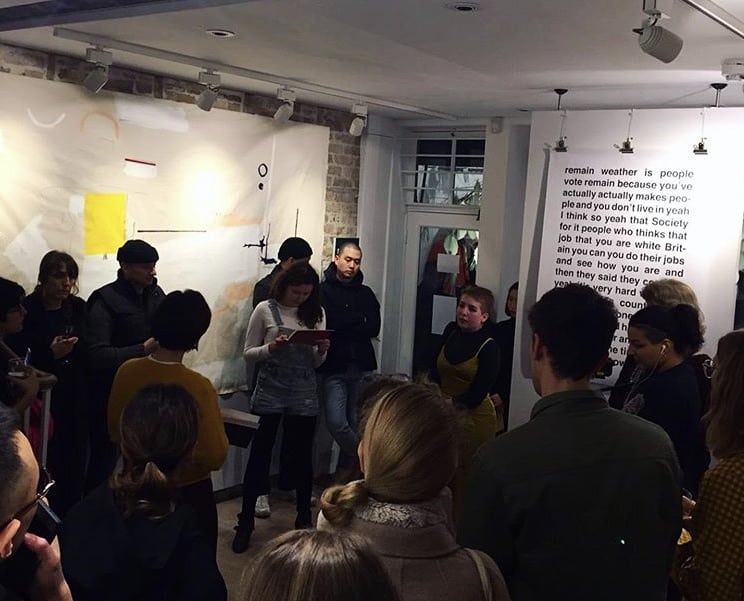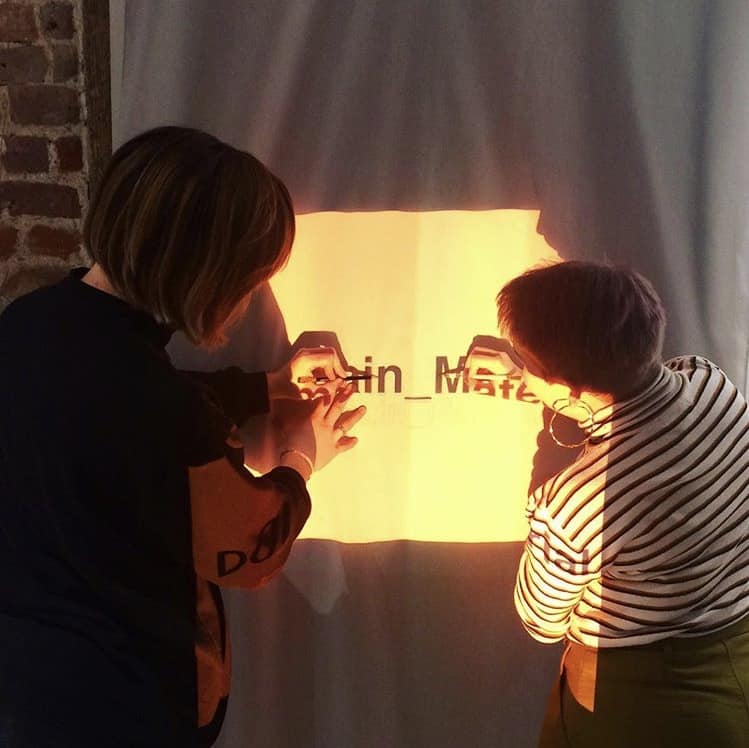We speak to Domain_Material, a collaborative duo who have recently completed a 6-week residency followed by “Reference Point” an exhibition at the One Paved Court gallery in Richmond Upon Thames, London. The exhibition included projection, installation, painting, embroidery, print and performance. During the residency the artists Amy Gillies and Chloe Hurst have developed their work into a project that questions how we receive, perceive and understand information and the political implications of these behaviours. The artists began by investigating various individual testimonies: Stanley William Renwick, a surgical appliance maker and former inhabitant of One Paved Court, Donald Ward, a poet, and Joseph McQueen a union mineworker, antecedents of Amy and Chloe respectively. Over the past six weeks the project has developed from the original case studies into a larger exploration and process-based investigation on political present. We speak to Amy and Chloe about their daily work during the residency stay and creation process.

Domain_Material
SK: How did you find out about the residency programme? How did you apply?
Amy: I found the residency on Instagram, it was as simple as that. Initially, I was really excited by the aim of the residency as it really spoke to what Chloe and I were trying to achieve by collaborating. We sent out a proposal outlining what we hoped to produce and gain from the Residency & Exhibition. We were then invited to attend an interview together in the Gallery.
By the time we interviewed for the residency we already had a foundation for context due to researching the space, so having a starting point and being able to demonstrate research worked was in our favour.
SK: What does your regular, art residency day look like?
Chloe: No day was the same, each day had its own schedule and this is mostly because the project was a dialogue between the two of us. None of our ideas were static; they were constantly being thrown back and forth between us. I think the project being a collaboration was to our benefit because it meant that we developed a continuous organic conversation throughout.
Typically, we would be at the gallery three or four days a week, and because we were combining our two practices, which vary in discipline, our days ranged with an abundance of materials and processes which included: reading material, research, sourced materials, print outs, sketches, projections, images, embroidery, painting, etc. Each day included a lot of experimentation with said materials, drawing together dialogues and connecting the research with physical elements.
A big part of our residency was involvement from the local community and invited creatives. Everyday visitors would come into the space to meet us, learn more about what we were doing and participate in our Virtual Map which consisted of answering verbally “What made you decide to vote for the first time?” and “What event politicised you?”, the answers were plotted on our Domain_Material Google Map in a location of significance to each verbal answer. We also had community engagement projects in which we invited the local community to develop work with us including a large-scale collaborative collage exploring the idea of speculative histories. Invited artists collaborated with us on a number of artworks which also fed into our exhibition including a large-scale embroidery/tapestry piece, a projection installation and a publication.

Domain_Material (Portrait Amy Gillies)
SK: In your experience, what distinguishes working as part of residencies from working in your atelier?
Amy: The residency provided us with a framework with which to generate our ideas and work toward the exhibition at the end of the residency. It also gave us the opportunity to combine our two practices and discover how our combined interests and skills would push the work forward.
Furthermore, collaboration was the defining aspect of the residency. From the beginning of our project, we agreed that we wanted multiple voices taking part in the research and making processes. This was probably the most important decision that we made during the residency.
The influx nature and the involvement of a multitude of people within the residency distinguished it from the assumed solo-artist means of production. For us the project relied on collaboration, accessibility and working with multiple voices.
SK: Does the change of context help you in the creation process?
Chloe: Definitely, it was clear from the original stages of the research that this project would not have existed in this particular form if we had applied separately. This is because it is a project that combines our two individual practices and this process of meeting in the middle has resulted in specific outcomes that could only have occurred through a collaboration and consistent dialogue.
Not only that, being in Richmond in a gallery set amongst retail and residential properties gave us a brand new perspective. We visited many places in Richmond that drove the project forward, for example going to the Old Town Hall and looking at the local archives and speaking to local people really helped us to understand our locality – geographically, socially and politically. In the end it became a core part of the research and was featured in several of the artworks in the exhibition.

Domain_Material
SK: Do you place an emphasis on your work or rather on meeting people and exploring the city?
Chloe: The core of the project was the engagement with the community, without the visitors input and their voices the project simply wouldn’t have happened. The work that we exhibited was naturally generated but a lot later on during the residency, our emphasis was definitely on research and producing dialogues.
SK: What challenges and opportunities did the residency involve?
Amy: We have never worked together before so I think we learnt a lot about each other and the ways in which we approach making. This may have begun as a challenge but it ultimately became a strength.
Moreover, by reaching out to friends and fellow artists, we gave ourselves the opportunity to collaborate with as many creative people as possible which in turn generated really interesting work. I don’t think the show would have been the same had it not been for the involvement of several other artists and it has been the starting point of multiple collaborations and creative projects.
Chloe: The initial research required us to visit several archives to uncover more information about the subjects that we were exploring. We sometimes struggled to find out the specific answers that we needed because the subjects we were looking into lived and died in the 19th and 20th century, where archival research is limited.
The residency gave us the opportunity to work with numerous people, artists and non-artists, strangers and friends, we created the parameters for interactions; however, each response varied greatly.
Tapestry, Embroidery on Cotton, 2020 (Featuring Mila Fan and Messua Wolff)
Text Work, Print on Paper, 2020
SK: Name three objects which are the most important to you during the residency.
Amy: We began our project with three publications which we referenced frequently throughout. These were the court files of Mr. Stanley William Renwick, ‘Adonis Blue’ by Donald Ward and the ‘National Mineworkers Union, 100 years of progress’ book. Without these three documents, the residency wouldn’t have been the same, they were fundamental to the project.
SK: What is the role of institution in your residency? What did it provide you with?
Chloe: I really appreciated that the gallery recognised that it is very difficult for emerging artists to exhibit in London. The fact that this residency was made available to us for free was so important. Galleries and spaces can be so inaccessible, so having the space in a beautiful location really gave us the opportunity to focus on our artwork.
Not only that, we also got to make the most of the connections that the gallery has. It’s well established in the Richmond area so we got to meet and talk with other creatives and regular visitors. This gave us a really unique perspective and opportunity to reflect on what we were doing.
Not to mention that the three artists that run the gallery also became great friends of ours, they hosted weekly meetings with us and provided us with a lot of support, materials and assistance, their input really helped to keep us moving in the right direction.

Domain_Material (Private View Performance)
Amy Gillies recently completed an MFA in Fine Art from Kingston School of Art, where she also studied a BA Hons in Fine Art and Art History. Since graduating, Amy has exhibited at the Solace Summit 2019 in Birmingham with Shared Press. She lives and works in London. Amy’s practice is concerned with the tension between the memory of the past and the politics of the present. Working predominantly in painting, performance and embroidery, she utilises pre-existing source material to speak to the condition of the current moment.
https://amygillies.com
IG: @amygilliesart
Chloë Hurst is the founder of Articulate, a monthly Spoken Word evening based in Bermondsey. She graduated from Kingston School of Art with an MA in Art & Space in 2018 and from Cambridge School of Art with BA Hons Fine Art in 2017. Recently Chloë has shown work as part of kut ArtBook Fair. She lives and works in London. Chloë’s practice is interdisciplinary, with inclusion of but not limited to sculpture, installation and digital art. In an attempt to show viewers the powerful reciprocal nature of vision, she presents a digitally mirrored, real-time spectacle. Her recent work has created a dialogue surrounding materiality, and social presence, by streaming real-time, live videos within sculptural installations, produced with everyday found materials.
https://chloehurst.net
IG: @chloehurst_art
The article was created thanks to the Arts Council Emergency Response Fund: for organisations (non NPO). Contemporary Lynx organisation is supported by Arts Council England.















